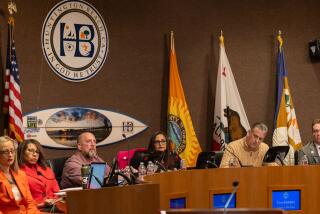Living in two Huntington Beaches
I tend to like children, and generally harbor positive thoughts about the future. But I had my doubts this summer, maybe like you, after the U.S. Open of Surfing crowd degenerated into marauding and brawling — young men clashing with police in riot gear, flipping over rows of porta-potties, ripping out street signs and using them to bash into local businesses.
They called it a “riot.” A riot, however, happens when there is at least the perception of some sort of injustice. This was no riot. It was a window — into a world that is both sun-baked and dark, a world where a celebration of youthful freedom clashes with grown-up excess.
I want to get it — be able to explain it to myself. A local guy named Eric Vedder was nice enough to sit down with me. Eric helped me understand it, because he’s lived it: There are two Huntington Beaches.
There’s the postcard version — Surf City, they call it. Beautiful weather, good eats, good shopping. Easygoing vibe, strong sense of community. Eight-plus miles of beach, unending curls of waves so iconic the Beach Boys had to give them a shout-out in “Surfin’ Safari.”
Then there’s the other one, which is more complicated.
Eight years ago, Vedder was living in Mission Viejo, a single father, he said, of a 9-year-old boy. Vedder was a salesman — labels and nameplates. He was also a longtime punk rocker who had played bass in a ton of bands and had grown up tough, one of four raised by a waitress mom.
Mission Viejo felt a little like Legoland, he said. Lots of gates. So off he and his son went to Huntington Beach. Vedder was drawn to it from the start. Who wouldn’t be? There’s a reason the city of 195,000 has a $100-million-plus tourism industry.
But before long, he started to see changes in his son.
The summer before Ian started middle school, he came home with two surprises. First — he was going to be the kind of kid who self-reported everything. Second — he’d tried his first cigarette.
“Did you like it?” Eric asked.
“I threw up.”
“You going to do it again?”
“Don’t think so.”
Before long, some older kids started to approach Ian, telling him that if anybody ever bothered him, they had his back. “He was starting to look up to them,” Eric said.
It turned out the kids were recruiters for gangs affiliated with skinheads. Eric started poking around and discovered skinheads, and even white supremacists, have been hanging out in Huntington Beach for a long time. They are far less visible today than they once were, no longer tied to a rash of violence and intimidation.
Still — Ian was 11. Eric got in touch with school officials. They told him, he said: “It’s just part of Huntington Beach.” After Ian declined to steal something for them, they took his bike.
“I was shocked. And bummed,” Eric said. “I had to tell him: ‘Those kids don’t have your back. I have your back.’”
Ian found a group of friends, kids who surfed, played sports, jammed on guitars. Eric knew they were smoking pot, too. Eric had been around plenty of partying over the years, and was no prude.
“Do as I say, and not as I do — I always thought that was good enough,” he said. “It wasn’t.”
Ian was plunged into a world of temptation — kids who were doing hard drugs; girls who asked him to do very specific and very adult things with them. The vibe, Eric felt, was more apathetic than easygoing — none of Ian’s friends, for example, wanted to go through the hassle of getting a driver’s license. Ian’s grades started to spiral; he even managed to get an F in P.E., because “only the lame kids dress out.”
“Things were — I don’t know. Faster here in Huntington Beach. It got pretty brutal,” Eric said. He was concerned that Ian, now 17, wouldn’t finish at Huntington Beach High.
The night of the so-called riot, Ian was at a friend’s house, and told his dad he wanted to go check it out. “I said: ‘Please don’t get in the middle of that,’” Eric said. Over the next 24 hours, father and son watched the reaction pour in over social media and the Internet.
Ian found one video that stuck with them both. People had smashed through the display window at Easyrider, a Main Street bike shop. They’d stolen one bike and were aiming for a second. Locals banded together to wrestle back the bike and save the shop; one was sucker-punched for his trouble.
To Eric and his son, it was evidence that the fateful night had been largely the work of outsiders, not locals. It was a display of community. “It restored our sense of pride,” Eric said.
In fact, the whole summer felt like a turning point. He helped his son get his first job, stocking shelves at an auto parts store — drove him there every day for two weeks to show him how you have to pester someone to get hired. His son is steady, heading into his last year of high school.
“I didn’t have the best role models, but I turned out OK, and so did he,” Eric said. “I got lucky. I got a sweet kid.”
More to Read
Sign up for Essential California
The most important California stories and recommendations in your inbox every morning.
You may occasionally receive promotional content from the Los Angeles Times.










